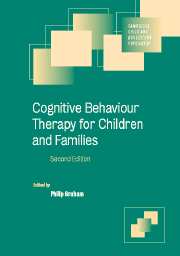Book contents
- Frontmatter
- Contents
- List of contributors
- 1 Introduction
- Part I Developmental cognitive theory and clinical practice
- Part II Engagement and assessment
- Part III Client groups
- Part IV Applications in psychosocial adversity
- Part V Applications in specific child and adolescent psychiatric disorders
- 12 Behavioural approaches to eating and sleeping problems in young children
- 13 Conduct disorders in young children
- 14 Attention deficit hyperactivity disorder
- 15 Children with developmental disabilities and their parents
- 16 Depressive disorders
- 17 Cognitive behavioural psychotherapy for obsessive compulsive disorders
- 18 Anxiety disorders
- 19 School refusal
- 20 Post-traumatic stress disorders
- 21 Disorders of eating control
- 22 Chronic fatigue syndrome
- 23 Children's interpersonal problems
- 24 Pain in childhood
- 25 Conduct disorders in adolescence
- 26 Drug and alcohol abuse
- Part VI CBT applications in preventive interventions
- Index
- References
20 - Post-traumatic stress disorders
Published online by Cambridge University Press: 21 August 2009
- Frontmatter
- Contents
- List of contributors
- 1 Introduction
- Part I Developmental cognitive theory and clinical practice
- Part II Engagement and assessment
- Part III Client groups
- Part IV Applications in psychosocial adversity
- Part V Applications in specific child and adolescent psychiatric disorders
- 12 Behavioural approaches to eating and sleeping problems in young children
- 13 Conduct disorders in young children
- 14 Attention deficit hyperactivity disorder
- 15 Children with developmental disabilities and their parents
- 16 Depressive disorders
- 17 Cognitive behavioural psychotherapy for obsessive compulsive disorders
- 18 Anxiety disorders
- 19 School refusal
- 20 Post-traumatic stress disorders
- 21 Disorders of eating control
- 22 Chronic fatigue syndrome
- 23 Children's interpersonal problems
- 24 Pain in childhood
- 25 Conduct disorders in adolescence
- 26 Drug and alcohol abuse
- Part VI CBT applications in preventive interventions
- Index
- References
Summary
Research over the last three decades has shown that children and adolescents who have been exposed to extreme stressors manifest a range of short- and long-term reactions, including anxiety, fears and depression, as well as post-traumatic stress disorder (PTSD). The diagnosis was initially controversial, particularly as applied to children, but has proven to be a useful framework for describing and understanding children's reactions to a variety of life-threatening experiences. This in turn has led to the refinement of interventions for children; broadly based cognitive behavioural therapies (CBTs) within a multi-modal, family-based approach are the treatment of choice.
Post-traumatic stress reactions in children and adolescents
PTSD was first recognized by the American Psychiatric Association in the third edition of the Diagnostic and Statistical Manual (American Psychiatric Association, 1980); and in the 1987 revision it was acknowledged that it can also occur in children. The most recent edition, DSM-IV (American Psychiatric Association, 1994), describes in more detail the way in which a number of symptoms may manifest in children. PTSD is defined as: (1) exposure to an event in which the person experienced, witnessed or was confronted with the actual or threatened death or serious injury, or a threat to the physical integrity of self or others, and in which the person's response involved intense fear, helplessness or horror; (2) persistent re-experiencing of the event; (3) persistent avoidance of related stimuli or numbing of responsiveness; and (4) persistent symptoms of increased arousal.
- Type
- Chapter
- Information
- Cognitive Behaviour Therapy for Children and Families , pp. 342 - 358Publisher: Cambridge University PressPrint publication year: 2004

